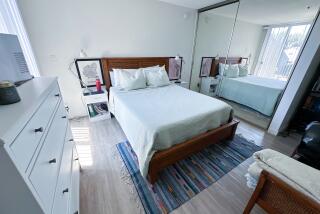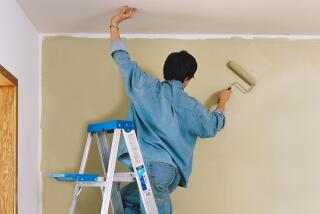Floor Richer, Floor Poorer : Considering the bottom line? Creativity can pave the way to surfaces that only look expensive.
Do you like the look of a hardwood floor but have a toothpick budget? Do you dream of marble entryways, but right now the only affordable marbles are the ones your kids are playing with?
Don’t worry. Creative flooring solutions are available to those who are willing to take a chance and let their imaginations go.
Designers are using cutting-edge ideas that are affordable, durable and attractive.
Newport Beach interior designer Nancy Duesenberg experiments with floors the way other people experiment with wall paint. The floors in her home are covered with thrown granite, marble, mosaics, limestone and Mexican pavers. The most unusual one, however, is the living room floor that is made of plywood, a combination of wood and synthetic glue that is flexible, strong and virtually unwarpable.
“Originally we had carpeting in the living room, but . . . it was a maintenance problem,” she says. “We wanted a particular look: quiet and soft, with a loft feel to it since we have the brick walls and the view of the Back Bay. Plus we wanted the room funky and less predictable. We’d already been through the all-white look where people were afraid to sit down and relax because they might get something dirty.”
By using plywood over plywood, Duesenberg got the look of a hardwood floor at a much more affordable price. “You can get bare, basic plywood for about $12 a sheet, which usually measures about 4 feet by 8 feet, in thicknesses of one-quarter, one-half or three-quarter inches. What you see here is the basic, complete with printing on it. I would say this is about a quarter of the cost of a hardwood floor.”
Duesenberg points out, however, that plywood can go as high as $45 a sheet if it’s of maple or birch. Those woods can give a room a very sophisticated look, especially if each piece is hand-picked so that there are no knot holes, printing or other flaws.
But even at the top end, plywood is still less expensive than other wood floors. If you don’t like the big sheets, plywood can be cut into 4-foot-by-4-foot squares, or even long strips.
“I think with plywood you can be much more versatile than with any other flooring right now,” Duesenberg says. “For example, you could cut 4-foot-by-4-foot squares and then cut six-inch wide pickets around them and stencil designs on the pickets. Or you could cut expensive wood into small squares to set into the plywood.”
Duesenberg suggests butt-joining the wood with each piece tight against each other, since nails, brads or screws won’t hold in the edges of the plywood. Or plywood can be nailed down in other parts of the wood so that nails don’t show.
For her home, Duesenberg put a fruitwood stain on the plywood, but any color stain works. Plywood can also be painted after any gaps in the edges of the panels have been filled in with wood putty or spackling compound. Apply a clear varnish finish if a more traditional look is desired.
Some of Duesenberg’s other flooring ideas are mixing limestone with slate and mosaics. Stone mixed with wood, stenciling a traditional hardwood floor and painting floors with harlequin prints or flowers are other suggestions.
Laurie Crogan, an artist/designer of inlay floors, has also been experimenting with different ideas in flooring. What she devised are one-of-a-kind floors using VCT (vinyl composition tile), terrazzo tile (marble chips and stone in a base of resin), cork and linoleum, which is made from cork and linseed oil.
“I’m a self-taught artist who was bored with the usual materials, so I developed this idea of cutting linoleum or vinyl into patterns and installing them on the floor,” says Crogan, who lives in Los Angeles.
When working with a client, Crogan draws four renderings of potential designs. The design depends on the architecture of the building and whether the home or business owner wants a traditional, whimsical, formal or neoclassical style, among others.
“Doing this job requires a lot of mechanical ability,” says Crogan. “I was lucky because my father was a builder who wanted sons and only had daughters. Because of that I grew up around tools and building equipment.”
After the design is agreed upon, Crogan measures the space and then draws the design to scale. “I design exactly on a grid system so I know where each tile will be placed. I then go to my studio and cut the tiles and number them so that when I get on the job site I can install them like a jigsaw puzzle. It helps that I have a jewelry background, so I know how to cut materials accurately.”
Crogan has done restoration work on some arts-and-crafts-style homes in Anaheim that have linoleum floors and has designed the commercial floor for Salon 218 in Huntington Beach using vinyl composition tile that is inexpensive and almost indestructible. Because the hair salon is near the ocean, Crogan incorporated vinyl waves, amorphous shapes and even a little green frog into the floor. In the facial salon, rectangles of different colors of vinyl were used to create a border.
She has created floors that look like abstract paintings, floors that resemble marble and cork floors that have a wood look to them. “Cork for flooring is very popular in Japan and Europe,” says Crogan. “I restored part of the cork floor in the Natural History Museum in Los Angeles recently. It’s an excellent material because it is long-lasting and it is great for soundproofing.”
Another flooring idea is painting concrete to resemble wood, stone, brick or marble. Mary Ann Ford of Painted Creations in Newport Beach recently completed painting a 2,600-square-foot concrete floor in an Italian-style villa to look as if it were made of marble.
“It’s a long process,” says Ford. “I start by using acid all over the floor to etch the concrete. The acid makes the concrete porous and gets rid of any dirt so the paint won’t peel off later on.”
After the floor dries, she applies a primer paint and then four to seven different related colors. “Adding the different colors is the hardest part,” she says. “It’s impossible to teach. You just have to have a sense of how the finished product will look.”
When applying the paint, Ford keeps in mind the traffic patterns of the floor and where light shines or where it’s dark. The paint is altered accordingly. “I also try to think about how a stone or marble cutter would cut the material. I want it to look authentic.”
In the house she recently painted, the concrete was diamond cut into blocks and then she painted each block separately.
“I add water-based varnish to the latex paint I use, and I apply the paint with sponges so you don’t see any brush marks,” she says. After the painting is done, she puts two to three coats of varnish over the whole floor.
“Besides costing about half of what a marble floor would, these floors are strong. You could run a herd of elephants through it and it wouldn’t be harmed,” she says.
Besides the marble-like floor, Ford has painted concrete to look like used brick, limestone and flagstone. “I liked that one because I painted little sprigs of grass growing between the stones and added some little ladybugs,” says Ford.
The common thread running through all of these floor ideas is the affordability and the uniqueness of each one.
“These floors let people live in and enjoy their houses,” says Duesenberg. “It’s good to get away from the ‘model home’ mentality. People are getting much more creative.”


